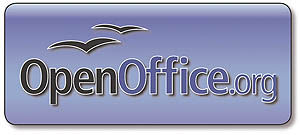As OpenOffice.org is a complete office suite, it contains a number of applications. The suite’s word-processing and spreadsheet programs, Writer and Calc, are undoubtedly the most common of these applications. However, the rest of the famous open-source suite is just as powerful:
OpenOffice.org Base
New in version 2.0 is OpenOffice.org Base, a database application similar to Microsoft Access, which is included in Office XP Professional.
Access users will feel at home in Base. Like Access, Base supports forms, queries, reports and table editing. Base also comes complete with a number of wizards to guide the user with complex tasks.
By default, Base uses the HSQL engine to store records and related information. However, Base can also use other data sources, like Microsoft Access, MySQL, dBASE and many other data sources via ODBC (Open Database Connectivity) or JDBC (Java Database Connectivity). Like JDBC, ODBC is a standard database access method which acts as a translator, converting commands from Base into a language the data source (database) can understand.
In Windows, ODBC can be configured from the ODBC data sources icon in the Control Panel (XP users may need to switch to “Classic View” to see it). Most Windows installations already include basic ODBC support. However, if needed, ODBC support can be acquired by downloading and installing MDAC (Microsoft Data Access Components) from Microsoft’s download site.
JDBC, on the other hand, requires that you have a working JRE (Java Runtime Environment) installed. Java (the JRE) can be acquired from www.java.com.
| OpenOffice.org Draw contains many drawing tools, including callout boxes, stars, scrolls, etc. |
OpenOffice.org Draw
OpenOffice.org Draw is a vector drawing program, and is great for creating simple graphics.
Draw is in no way a competitor to major vector drawing programs like Corel DRAW, Adobe Illustrator or Macromedia Freehand, which are far more powerful. In contrast, however, Draw is designed to be capable, but simple and easy to use.
Draw includes all the basic tools a drawing program should have. Various shapes (rectangles, circles, callouts, stars, scrolls, clouds, etc.) can be created, and can be filled with various colors or gradients. Lines and arrows can be created. Text can be added, and various text effects can be applied.
Objects easily snap to the grid, which is on by default. Grid properties can be adjusted as necessary.
Draw’s design makes it well suited for simple flow-charts and diagrams.
One of Draw’s great features is object size control. For example, suppose a circle needs to have a diameter of exactly 2.75 inches – Draw makes this easy (right-click the circle, and select “Position and Size”).
Like all OpenOffice.org applications, Draw has a PDF export feature, which allows copies of the image to be created in the PDF format. This makes importing your Draw graphics into other programs very easy.
| OpenOffice.org Impress uses various viewing modes to make presentation editing and viewing easier. Impress also shares many of the same drawing tools as OpenOffice.org Draw. Once a presentation is created, it can be saved as a Microsoft PowerPoint or Flash (SWF) file. |
OpenOffice.org Impress
OpenOffice.org Impress is a multimedia presentation program, similar to Microsoft PowerPoint.
Like PowerPoint, Impress supports a multitude of multimedia types: vector graphics, pictures, audio & video, charts & more. Impress also does a number of slide transitions, and utilizes several different viewing modes to make editing easier.
Impress can saves presentations, by default, in the new OpenDocument file format, but can also edit and create Microsoft PowerPoint files.
One of it’s best features is its ability to save the presentation to Flash (SWF) format, which can be opened in most Internet browsers (Microsoft Internet Explorer, Mozilla Firefox, Opera, and others).
OpenOffice.org also comes bundled with OpenOffice.org Math, a mathematical formula creation and analysis tool. Although this program definitely has its use, most home users will probably not find themselves using it much.
If you are unsure if OpenOffice.org is for you, download it for free from their homepage, and give it a try. Or, alternatively, go to your favorite search engine (like google.com), search for “OpenOffice.org 2.0 review” and read what others have to say about it.
If you decide to give OpenOffice.org a test run, you may also find www.oooforum.org (great for getting technical help) and www.ooodocs.org (a great place to find templates, macros and other files) a big help.
OpenOffice.org can be downloaded, free of charge, from www.openoffice.org.
Have comments or suggestions for a weekly Tech Tips article? Send an email to webmaster@sunad.com.
Note: The Sun Advocate and Emery County Progress do not necessarily endorse the opinions of the author.

